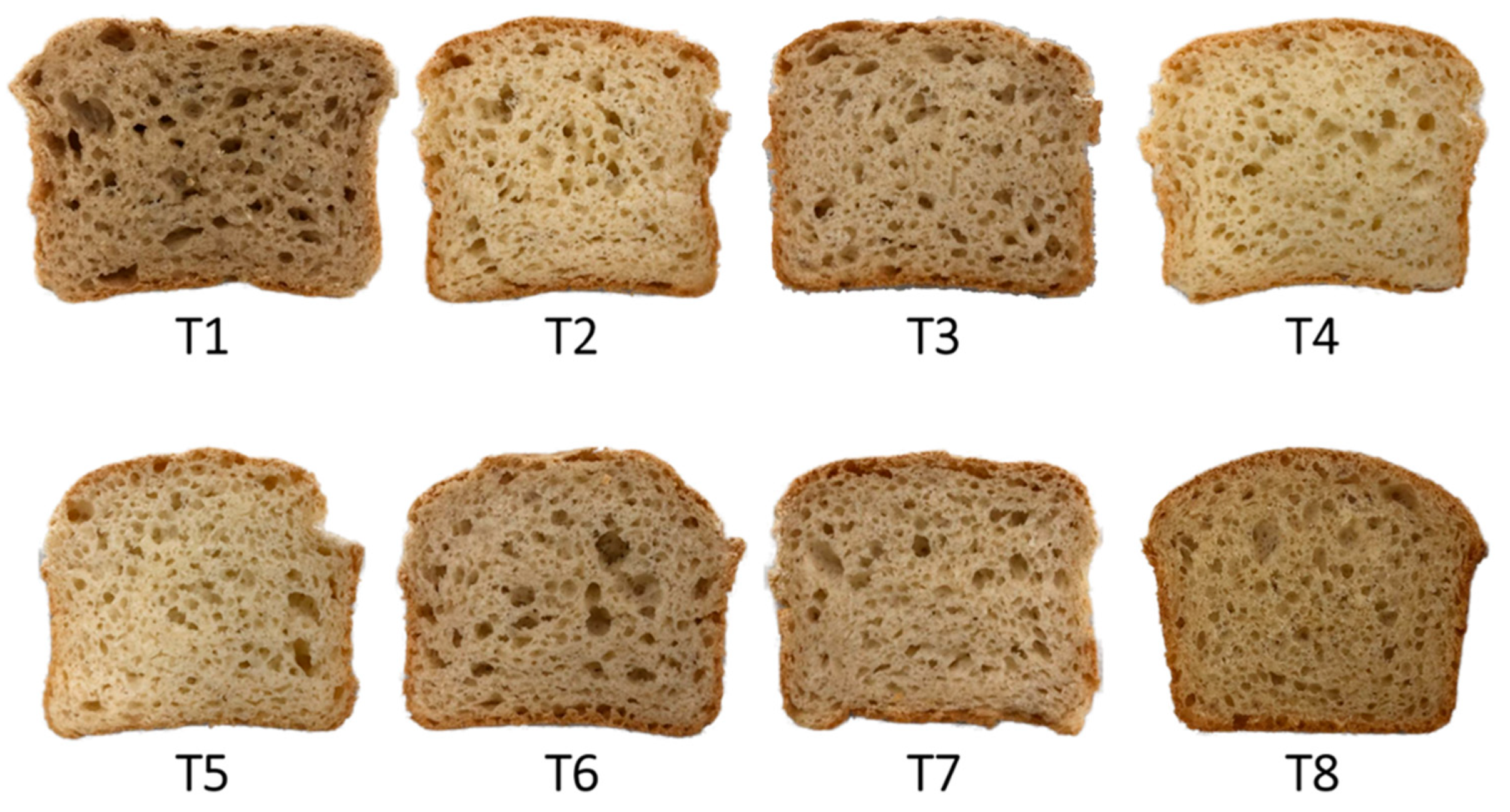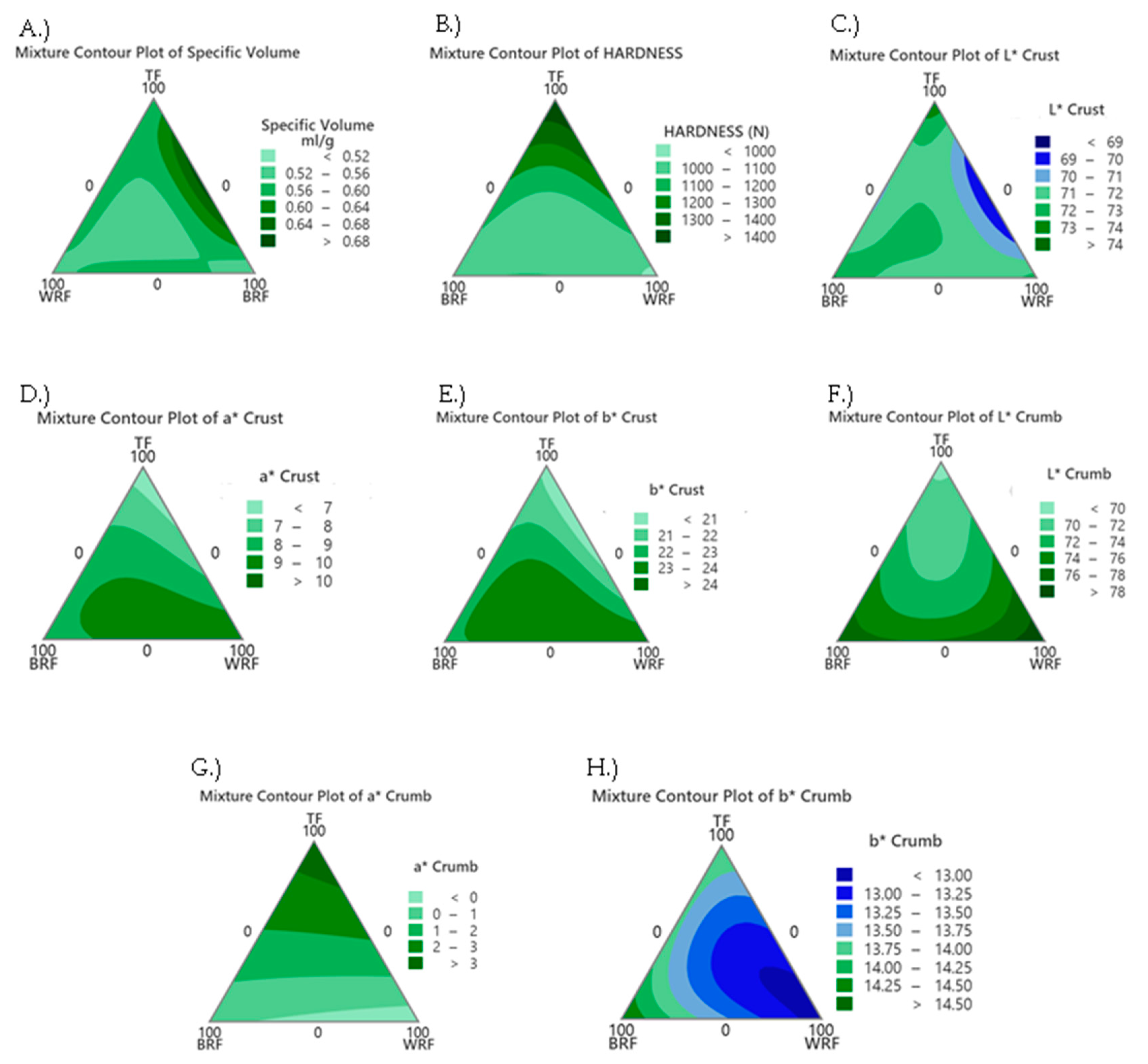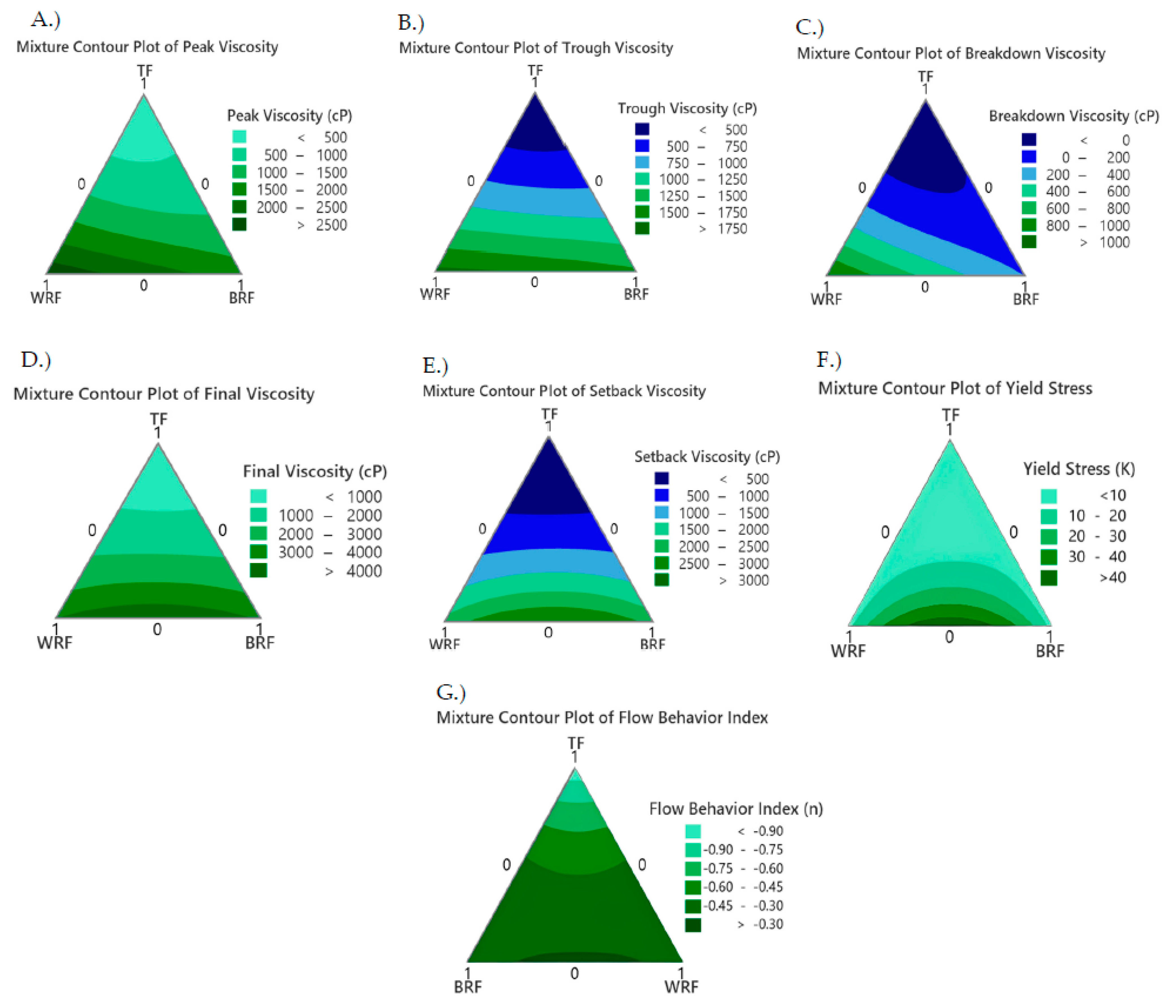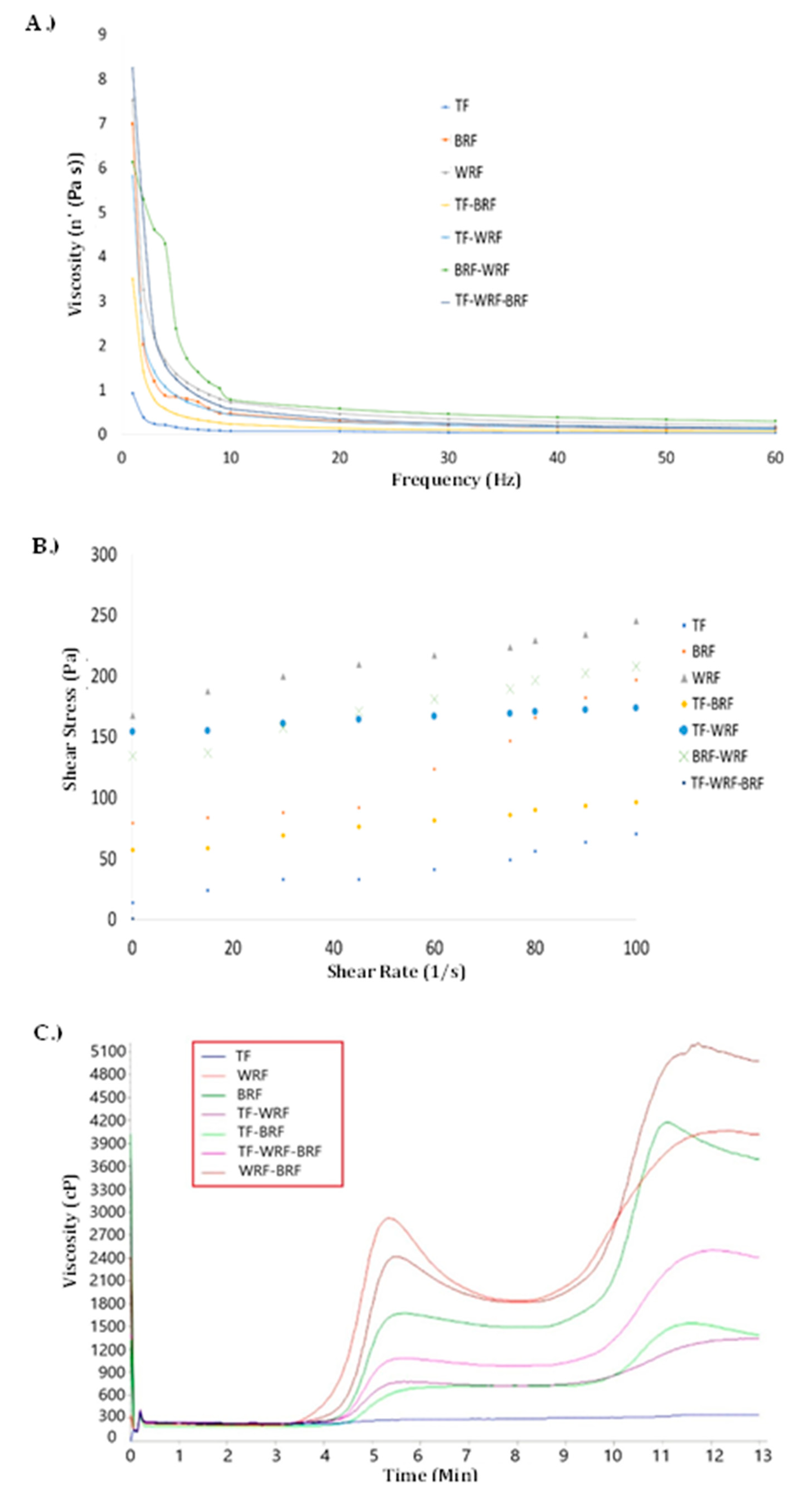Development of Gluten-Free Bread Using Teosinte (Dioon mejiae) Flour in Combination with High-Protein Brown Rice Flour and High-Protein White Rice Flour
Abstract
1. Introduction
2. Material and Method
2.1. Experimental Design
2.2. Preparing the Bread
2.3. Flour Rheological and Pasting Properties
2.4. Bread Physical Features
2.5. Statistical Analysis
3. Results and Discussion
3.1. Bread Characteristics
3.2. Flour Pasting and Rheological Properties
| Response | TF | BRF | WRF | TF-BRF | TF-WRF | BRF-WRF | TF-BRF-WRF | R2 |
|---|---|---|---|---|---|---|---|---|
| Specific Volume (mL/g) | 0.01 | 0.01 | 0.01 | >0.01 | >0.01 | >0.01 | >0.01 | 87.0% |
| Hardness (N) | 14.9 | 10.5 | 9.68 | −0.03 | 0.01 | 0.03 | −0.03 | 92.8% |
| L* (Crust) | 0.74 | 0.73 | 0.72 | >−0.01 | >−0.01 | >−0.01 | >0.01 | 80.9% |
| a∗ (Crust) | 0.06 | 0.08 | 0.10 | 0.01 | >−0.01 | >0.01 | >0.01 | 95.6% |
| b∗ (Crust) | 0.20 | 0.22 | 0.24 | >0.01 | >−0.01 | >0.01 | >0.01 | 87.7% |
| L* (Crumb) | 0.69 | 0.77 | 0.79 | >−0.01 | >−0.01 | >−0.01 | >−0.01 | 92.7% |
| a* (Crumb) | 0.03 | >0.01 | >−0.01 | >0.01 | >0.01 | >−0.01 | >−0.01 | 99.4% |
| b* (Crumb) | 0.14 | 0.15 | 0.12 | >−0.01 | >−0.01 | >−0.01 | >−0.01 | 75.5% |
| Peak Viscosity (cP) | 275 | 2848.3 | 1739.7 | −2909 | −1164 | −29 | −2533 | 99.2% |
| Trough Viscosity (cP) | 268.3 | 1811.7 | 1541.3 | −1128 | −814 | 181 | −1253 | 98.6% |
| Breakdown Viscosity (cP) | 6.7 | 1036.7 | 198.3 | −1781.3 | −350 | −210 | −1280 | 99.6% |
| Final Viscosity (cP) | 324 | 3969 | 3854 | −2883 | −2805 | 3370 | −7483 | 98.1% |
| Setback Viscosity (cP) | 56 | 2158 | 2312 | −1755 | −1991 | 3189 | −6230 | 97.7% |
| Flow behavior index (n) | 0.85 | 0.31 | 0.44 | 1.31 | 1.27 | 0.41 | 1.12 | 95.8% |
| Yield Stress (K) | 5.72 | 7.19 | 6.83 | −2.92 | 3.65 | 166.90 | −367 | 97.4% |
4. Conclusions
Author Contributions
Funding
Data Availability Statement
Conflicts of Interest
References
- Cappelli, A.; Cini, E.; Guerrini, L.; Masella, P.; Angeloni, G.; Parenti, A. Predictive models of the rheological properties and optimal water content in doughs: An application to ancient grain flours with different degrees of refining. J. Cereal Sci. 2018, 83, 229–235. [Google Scholar] [CrossRef]
- Ren, Y.; Linter, B.R.; Linforth, R.; Foster, T.J. A comprehensive investigation of gluten free bread dough rheology, proving and baking performance and bread qualities by response surface design and principal component analysis. Food Funct. 2020, 11, 5333–5345. [Google Scholar] [CrossRef] [PubMed]
- Rej, A.; Aziz, I.; Sanders, D.S. Breaking bread! Proc. Nutr. Soc. 2019, 78, 118–125. [Google Scholar] [CrossRef] [PubMed]
- Lebwohl, B.; Sanders, D.S.; Green, P.H.R. Coeliac disease. Lancet 2018, 391, 70–81. [Google Scholar] [CrossRef] [PubMed]
- Bender, D.; Schönlechner, R. Innovative approaches towards improved gluten-free bread properties. J. Cereal Sci. 2020, 91, 102904. [Google Scholar] [CrossRef]
- Capriles, V.D.; Arêas, J.A.G. Novel Approaches in Gluten-Free Breadmaking: Interface between Food Science, Nutrition, and Health. Compr. Rev. Food Sci. Food Saf. 2014, 13, 871–890. [Google Scholar] [CrossRef]
- de la Hera, E.; Martinez, M.; Gómez, M. Influence of flour particle size on quality of gluten-free rice bread. LWT—Food Sci. Technol. 2013, 54, 199–206. [Google Scholar] [CrossRef]
- Skendi, A.; Mouselemidou, P.; Papageorgiou, M.; Papastergiadis, E. Effect of acorn meal-water combinations on technological properties and fine structure of gluten-free bread. Food Chem. 2018, 253, 119–126. [Google Scholar] [CrossRef]
- Roman, L.; Belorio, M.; Gomez, M. Gluten-Free Breads: The Gap Between Research and Commercial Reality. Compr. Rev. Food Sci. Food Saf. 2019, 18, 690–702. [Google Scholar] [CrossRef]
- Wu, J.; McClements, D.J.; Chen, J.; Hu, X.; Liu, C. Improvement in nutritional attributes of rice using superheated steam processing. J. Funct. Foods 2016, 24, 338–350. [Google Scholar] [CrossRef]
- Bastias-Montes, J.M.; Flores-Varela, L.E.; Reyes-Calderón, O.A.; Vidal-San-Martín, C.; Muñoz-Fariña, O.; Quevedo-León, R.; Acuña-Nelson, S.M. Teosinte (Dioon mejiae) flour: Nutritional and physicochemical characterization of the seed flour of the living fossil in honduras. Agronomy 2020, 10, 481. [Google Scholar] [CrossRef]
- Comino, I.; de Lourdes Moreno, M.; Real, A.; Rodríguez-Herrera, A.; Barro, F.; Sousa, C. The Gluten-Free Diet: Testing Alternative Cereals Tolerated by Celiac Patients. Nutrients 2013, 5, 4250–4268. [Google Scholar] [CrossRef]
- Hozyasz, K.K. Letter to the Editor Re: Comino, I.; et al. Nutrients 2013, 5, 4250–4268. Nutrients 2013, 5, 4964–4965. [Google Scholar] [CrossRef] [PubMed]
- Saturni, L.; Ferretti, G.; Bacchetti, T. The Gluten-Free Diet: Safety and Nutritional Quality. Nutrients 2010, 2, 16–34. [Google Scholar] [CrossRef] [PubMed]
- Amador, M.; Montilla, I.M.C.; Martín, C.S. Alternative grains as potential raw material for gluten—Free food development in the diet of celiac and gluten—Sensitive patients. Austin J. Nutr. Metab. 2014, 2, 1–9. [Google Scholar]
- Bonta, M.; Pinot, O.; Graham, D.; Haynes, J.; Sandoval, G. Ethnobotany and conservation of tiusinte (Dioon mejiae Standl. & LO Williams, Zamiaceae) in northeastern Honduras. J. Ethnobiol. 2006, 26, 228–257. [Google Scholar]
- Han, A.; Romero, H.M.; Nishijima, N.; Ichimura, T.; Handa, A.; Xu, C.; Zhang, Y. Effect of egg white solids on the rheological properties and bread making performance of gluten-free batter. Food Hydrocoll. 2019, 87, 287–296. [Google Scholar] [CrossRef]
- Gujral, H.S.; Guardiola, I.; Carbonell, J.V.; Rosell, C.M. Effect of cyclodextrinase on dough rheology and bread quality from rice flour. J. Agric. Food Chem. 2003, 51, 3814–3818. [Google Scholar] [CrossRef] [PubMed]
- Ribotta, P.D.; Ausar, S.F.; Morcillo, M.H.; Pérez, G.T.; Beltramo, D.M.; León, A.E. Production of gluten-free bread using soybean flour. J. Sci. Food Agric. 2004, 84, 1969–1974. [Google Scholar] [CrossRef]
- Rostamian, M.; Milani, J.M.; Maleki, G. Physical properties of gluten-free bread made of corn and chickpea flour. Int. J. Food Eng. 2014, 10, 467–472. [Google Scholar] [CrossRef]
- Smidova, Z.; Rysova, J. Gluten-free bread and bakery products technology. Foods 2022, 11, 480. [Google Scholar] [CrossRef] [PubMed]
- Amdoun, R.; Khelifi, L.; Khelifi-Slaoui, M.; Amroune, S.; Asch, M.; Assaf-ducrocq, C.; Gontier, E. The Desirability Optimization Methodology; a Tool to Predict Two Antagonist Responses in Biotechnological Systems: Case of Biomass Growth and Hyoscyamine Content in Elicited Datura starmonium Hairy Roots. Iran. J. Biotechnol. 2018, 16, 11–19. [Google Scholar] [CrossRef]
- AACC. Approved Methods of the AACC: Method 61.02.01 (Pasting Properties), 11th ed.; American Association of Cereal Chemists: St. Paul, MN, USA, 2012. [Google Scholar]
- Ye, J.; Wang, J.; Zhu, Y.; Wei, Q.; Wang, X.; Yang, J.; Tang, S.; Liu, H.; Fan, J.; Zhang, F.; et al. A thermoresponsive polydiolcitrate-gelatin scaffold and delivery system mediates effective bone formation from BMP9-transduced mesenchymal stem cells. Biomed. Mater. 2016, 11, 025021. [Google Scholar] [CrossRef] [PubMed]
- AACC. Approved Methods of the AACC, 10th ed.; Methods of 10-05, 10-91, 44-15, and 74-09; American Association of Cereal Chemists: St. Paul, MN, USA, 2000. [Google Scholar]
- Kadan, R.S.; Robinson, M.G.; Thibodeaux, D.P.; Pepperman, A.B. Texture and other physicochemical properties of whole rice bread. J. Food Sci. 2001, 66, 940–944. [Google Scholar] [CrossRef]
- Aleman, R.S.; Paz, G.; Prinyawiwatkul, W.; Moncada, M.; King, J.M. Comparison of the Thermal and Rheological Properties of Frontière Brown Rice Flour, Tapioca Starch, and Potato Starch and Mixture Effects on Pasting Properties in Aqueous Systems. Starch-Stärke 2023, 2200196. [Google Scholar] [CrossRef]
- Aleman, R.S.; Paz, G.; Morris, A.; Prinyawiwatkul, W.; Moncada, M.; King, J.M. High protein brown rice flour, tapioca starch & potato starch in the development of gluten-free cupcakes. LWT 2021, 152, 112326. [Google Scholar] [CrossRef]
- Monteiro, J.S.; Farage, P.; Zandonadi, R.P.; Botelho, R.B.A.; de Oliveira, L.D.L.; Raposo, A.; Shakeel, F.; Alshehri, S.; Mahdi, W.A.; Araújo, W.M.C. A systematic review on gluten-free bread formulations using specific volume as a quality indicator. Foods 2021, 10, 614. [Google Scholar] [CrossRef] [PubMed]
- Ziobro, R.; Juszczak, L.; Witczak, M.; Korus, J. Non-gluten proteins as structure forming agents in gluten free bread. J. Food Sci. Technol. 2016, 53, 571–580. [Google Scholar] [CrossRef]
- Paz, G.M.; King, J.M.; Prinyawiwatkul, W. High Protein Rice Flour in the Development of Gluten-Free Bread. J. Culin. Sci. Technol. 2021, 19, 315–330. [Google Scholar] [CrossRef]
- Korus, A.; Witczak, M.; Korus, J.; Juszczak, L. Dough Rheological Properties and Characteristics of Wheat Bread with the Addition of Lyophilized Kale (Brassica oleracea L. var. sabellica). Powder. Appl. Sci. 2022, 13, 29. [Google Scholar] [CrossRef]
- Sanjyal, S.; Hampton, J.G.; Rolston, P.; Marahatta, S. Teosinte (Euchlaena mexicana L.) Seed Production: Effect of Sowing Date, Seed Rate and Cutting Management on Seed Yield. Agronomy 2022, 12, 1646. [Google Scholar] [CrossRef]
- Lamberts, L.; Delcour, J.A. Carotenoids in raw and parboiled brown and milled rice. J. Agric. Food Chem. 2008, 56, 11914–11919. [Google Scholar] [CrossRef] [PubMed]
- Leon, E.; Piston, F.; Aouni, R.; Shewry, P.R.; Rosell, C.M.; Martin, A.; Barro, F. Pasting properties of transgenic lines of a commercial bread wheat expressing combinations of HMW glutenin subunit genes. J. Cereal Sci. 2010, 51, 344–349. [Google Scholar] [CrossRef]
- Zhou, D.N.; Zhang, B.; Chen, B.; Chen, H.Q. Effects of oligosaccharides on pasting, thermal and rheological properties of sweet potato starch. Food Chem. 2017, 230, 516–523. [Google Scholar] [CrossRef]
- Aleman, R.S.; Morris, A.; Prinyawiwatkul, W.; Moncada, M.; King, J.M. Physicochemical properties of Frontière rice flour and its application in a gluten-free cupcake. Cereal Chem. 2022, 99, 303–315. [Google Scholar] [CrossRef]
- Singh Sandhu, K.; Singh, N.; Lim, S.T. A comparison of native and acid thinned normal and waxy corn starches: Physicochemical, thermal, morphological and pasting properties. LWT 2007, 40, 1527–1536. [Google Scholar] [CrossRef]
- Ragaee, S.; Abdel-Aal, E.S.M. Pasting properties of starch and protein in selected cereals and quality of their food products. Food Chem. 2006, 95, 9–18. [Google Scholar] [CrossRef]
- Ohizua, E.R.; Adeola, A.A.; Idowu, M.A.; Sobukola, O.P.; Afolabi, T.A.; Ishola, R.O.; Ayansina, S.O.; Oyekale, T.O.; Falomo, A. Nutrient composition, functional, and pasting properties of unripe cooking banana, pigeon pea, and sweetpotato flour blends. Food Sci. Nutr. 2017, 5, 750–762. [Google Scholar] [CrossRef]




| Treatments | *TF | *BRF | *WRF |
|---|---|---|---|
| ▪ TF alone | 100% | 0% | 0% |
| ▪ BRF alone | 0% | 100% | 0% |
| ▪ WRF alone | 0% | 0% | 100% |
| ▪ TF-BRF | 50% | 50% | 0% |
| ▪ TF-WRF | 50% | 0% | 50% |
| ▪ BRF-WRF | 0% | 50% | 50% |
| ▪ TF-BRF-WRF | 33.337% | 33.337% | 33.337% |
| Gluten Free Breads | Control Bread | ||
|---|---|---|---|
| Ingredients | Percentage | Ingredient | Percentage |
| Flour * | 17.09% | All purpose flour | 42.32% |
| Tapioca flour | 14.64% | Whole wheat flour | 10.83% |
| Sugar | 3.33% | Sugar | 6.66% |
| Salt | 0.98% | Salt | 1.50% |
| Active dry yeast | 0.88% | Active dry yeast | 1.17% |
| Water | 32.2% | Water | 30.67% |
| Vegetable oil | 1.47% | Vegetable oil | 4.89% |
| Vanilla | 1.96% | Vanilla | 1.96% |
| Cornstarch | 16.11% | ||
| Egg | 9.76% | ||
| Xanthan gum | 0.78% | ||
| Baking powder | 0.49% | ||
| Apple cider vinegar | 0.29% | ||
Disclaimer/Publisher’s Note: The statements, opinions and data contained in all publications are solely those of the individual author(s) and contributor(s) and not of MDPI and/or the editor(s). MDPI and/or the editor(s) disclaim responsibility for any injury to people or property resulting from any ideas, methods, instructions or products referred to in the content. |
© 2023 by the authors. Licensee MDPI, Basel, Switzerland. This article is an open access article distributed under the terms and conditions of the Creative Commons Attribution (CC BY) license (https://creativecommons.org/licenses/by/4.0/).
Share and Cite
Delarca Ruiz, F.; Aleman, R.S.; Kazemzadeh Pournaki, S.; Sarmiento Madrid, M.; Muela, A.; Mendoza, Y.; Marcia Fuentes, J.; Prinyawiwatkul, W.; King, J.M. Development of Gluten-Free Bread Using Teosinte (Dioon mejiae) Flour in Combination with High-Protein Brown Rice Flour and High-Protein White Rice Flour. Foods 2023, 12, 2132. https://doi.org/10.3390/foods12112132
Delarca Ruiz F, Aleman RS, Kazemzadeh Pournaki S, Sarmiento Madrid M, Muela A, Mendoza Y, Marcia Fuentes J, Prinyawiwatkul W, King JM. Development of Gluten-Free Bread Using Teosinte (Dioon mejiae) Flour in Combination with High-Protein Brown Rice Flour and High-Protein White Rice Flour. Foods. 2023; 12(11):2132. https://doi.org/10.3390/foods12112132
Chicago/Turabian StyleDelarca Ruiz, Franklin, Ricardo S. Aleman, Shirin Kazemzadeh Pournaki, Mallerly Sarmiento Madrid, Andrea Muela, Yeimi Mendoza, Jhunior Marcia Fuentes, Witoon Prinyawiwatkul, and Joan M. King. 2023. "Development of Gluten-Free Bread Using Teosinte (Dioon mejiae) Flour in Combination with High-Protein Brown Rice Flour and High-Protein White Rice Flour" Foods 12, no. 11: 2132. https://doi.org/10.3390/foods12112132
APA StyleDelarca Ruiz, F., Aleman, R. S., Kazemzadeh Pournaki, S., Sarmiento Madrid, M., Muela, A., Mendoza, Y., Marcia Fuentes, J., Prinyawiwatkul, W., & King, J. M. (2023). Development of Gluten-Free Bread Using Teosinte (Dioon mejiae) Flour in Combination with High-Protein Brown Rice Flour and High-Protein White Rice Flour. Foods, 12(11), 2132. https://doi.org/10.3390/foods12112132





